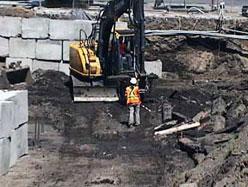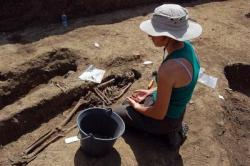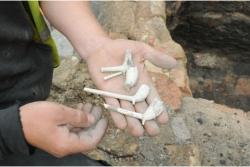- 20 JUILLET
- INDI-UNI : 
PRE-INSCRIPTION : 15 Juin – 15 Août
PRE-REGISTRATION: June 15th - August 15th
- FRANCE – Jublains - Une vingtaine de jeunes travaille actuellement sur la domus (riche demeure romaine) pour la seconde saison de fouilles à Jublains, sous la direction de Anne Bocquet, archéologue départementale. Après avoir dégagé le plan de la domus, en terrasse sur trois niveaux, les archéologues explorent quelques salles de la maison. Presque chaque jour des découvertes permettent de nouvelles précisions : des objets récoltés du 1 er au III e siècle après JC, un puits mis à jour avec une base de pilier tombée au fond, des traces d'enduit et de décorations, des empreintes de feuilles. Mais aussi des ossements d'animaux, une salle, dite hypocauste, d'habitation chauffée au sol ou therme privé... Et des traces plus anciennes de la présence d'habitats gaulois. La trouvaille plus émouvante est une statuette de la déesse mère, très rare. Il n'en existe que deux autres en France.Étant donné la richesse archéologique du site, plusieurs saisons de fouilles seront nécessaires : « L'autre site, tout proche, a demandé six saisons de fouilles pour pouvoir l'interpréter comme quartier artisanal gaulois, traces du travail du fer et autres. » explique Elsa, archéologue spécialiste en archo-zoologie. Surtout que la partie dégagée n'est pas la totalité de la domus qui, on le sait grâce aux radios de sol et aux sondages, se prolonge jusqu'à la voie romaine.La domus est non seulement sur trois niveaux mais elle a évolué pendant quelques siècles. Selon les couches dégagées, on découvre différents tracés de murs. Une analyse complexe qui demandera à chaque fin de saison un travail de « post-fouilles.
http://www.ouest-france.fr/actu/actuLocale_-Les-archeologues-explorent-la-domus-diablintes-_53028-avd-20110717-60917457_actuLocale.HtmChiar
- CANADA –  Québec - Un des plus vieux chantiers navals d'Amérique est détruit pour faire place à un immeuble d'habitation, à Québec. L'ancien chantier naval, situé près de la rue des Vaisseaux-du-Roi, daterait de près de 300 ans. «On est dans le patrimoine de l'UNESCO, souligne Gérald Jean, un citoyen de Québec qui a tout fait pour arrêter la destruction des vestiges. C'est le chantier naval des Vaisseaux-du-Roi, un chantier qui date d'environ 1759. On espérait qu'il le conserve, mais ce n'est pas le cas.» À peine déterrés, les vestiges en bois sont marqués sans grandes distinctions puis fracassés sous la force de la machinerie.
Québec - Un des plus vieux chantiers navals d'Amérique est détruit pour faire place à un immeuble d'habitation, à Québec. L'ancien chantier naval, situé près de la rue des Vaisseaux-du-Roi, daterait de près de 300 ans. «On est dans le patrimoine de l'UNESCO, souligne Gérald Jean, un citoyen de Québec qui a tout fait pour arrêter la destruction des vestiges. C'est le chantier naval des Vaisseaux-du-Roi, un chantier qui date d'environ 1759. On espérait qu'il le conserve, mais ce n'est pas le cas.» À peine déterrés, les vestiges en bois sont marqués sans grandes distinctions puis fracassés sous la force de la machinerie.
http://fr.canoe.ca/infos/quebeccanada/archives/2011/07/20110719-174207.html
- FRANCE –  Saint Dizier - Depuis quinze jours, le site des Crassés (au Chêne Saint-Amand) fait l'objet d'une campagne de fouilles archéologiques par des étudiants. Plusieurs tombes ont été retrouvées. Un espace mis au jour dans les années soixante par Louis Lepage puis bien plus tard, en 2004, suite à la découverte de tombes de chefs mérovingiens qui avaient fait l'objet d'une exposition à renommée nationale. Après la découverte des tombes des chefs à quelques centaines de mètres, le site des Crassés représentait un intérêt scientifique. C'est pourquoi un dossier a été déposé auprès de l'État afin de réaliser des fouilles programmées. Il durera plusieurs années. Selon Stéphanie Desbrosses-Dégobertière, « les nécropoles mérovingiennes sont en général situées sur des pentes comme ici. Les meilleures terres étant réservées à l'agriculture. Cependant, la position des squelettes et l'absence d'objets indiquent qu'ils seraient de la période carolingienne. Les Mérovingiens sont enterrés les bras sur le corps contrairement aux carolingiens », précise-t-elle.
Saint Dizier - Depuis quinze jours, le site des Crassés (au Chêne Saint-Amand) fait l'objet d'une campagne de fouilles archéologiques par des étudiants. Plusieurs tombes ont été retrouvées. Un espace mis au jour dans les années soixante par Louis Lepage puis bien plus tard, en 2004, suite à la découverte de tombes de chefs mérovingiens qui avaient fait l'objet d'une exposition à renommée nationale. Après la découverte des tombes des chefs à quelques centaines de mètres, le site des Crassés représentait un intérêt scientifique. C'est pourquoi un dossier a été déposé auprès de l'État afin de réaliser des fouilles programmées. Il durera plusieurs années. Selon Stéphanie Desbrosses-Dégobertière, « les nécropoles mérovingiennes sont en général situées sur des pentes comme ici. Les meilleures terres étant réservées à l'agriculture. Cependant, la position des squelettes et l'absence d'objets indiquent qu'ils seraient de la période carolingienne. Les Mérovingiens sont enterrés les bras sur le corps contrairement aux carolingiens », précise-t-elle.
De plus, un seul linceul a été identifié pour l'instant, « près de la tombe la plus large ».
Les fosses sont, elles, très serrées et peu profondes. Des caractéristiques « de l'époque mérovingienne ». « Les morts n'ont pas été enterrés à la hâte, dans une fosse commune puisque chaque tombe est bien différenciée, individualisée. Pour information, au niveau des enterrements, les Mérovingiens respectaient les époques antérieures et ne déplaçaient pas les tombes, par respect ».
http://www.lunion.presse.fr/article/culture-et-loisirs/des-fouilles-archeologiques-sur-le-site-des-crasses
- ROYAUME UNI –  Bath - Archaeologists investigating a site in Bath have found evidence of the grip on life of smoking two centuries ago. A dig at a city centre car park has unearthed clay smoking pipes.The pipes were discovered by specialists exploring the area under the Sawclose car park. They date back to the 19th century, when there was a factory at the site.
Bath - Archaeologists investigating a site in Bath have found evidence of the grip on life of smoking two centuries ago. A dig at a city centre car park has unearthed clay smoking pipes.The pipes were discovered by specialists exploring the area under the Sawclose car park. They date back to the 19th century, when there was a factory at the site.
http://www.thisisbath.co.uk/smoking-room-19th-century-uncovered-Bath/story-12971393-detail/story.html
- ROYAUME UNI – Udal - Comhairle nan Eilean Siar’s Archaeology Service has recently secured a grant from Historic Scotland equivalent to 70% of the cost of the ambitious Udal project in North Uist. The Udal is one of the most important archaeological sites in the UK, having been continuously occupied for some 5,000 years. Between 1963 and 1995 a major research excavation was undertaken on the site. Excavated by a charismatic and passionate director, Ian Crawford, the Udal was technically ahead of its time, having been one of the first sites to use the modern techniques that archaeologists now take for granted. During the excavations, Mr Crawford discovered a huge and highly significant landscape of domestic occupation, funerary and ritual behaviour dating from around 3,000BC to the 20th century. Rod McCullagh, Historic Scotland Archaeologist, said: “The site name Udal, in North Uist, already has a place in archaeological literature but most texts refer to its potential; we know it as a place where answers to many key questions might one day emerge. “With over 3,000 years of human settlement and displaying many phases in elaborate well-preserved detail, the Udal deserves a much wider dissemination and will stand comparison with most major monuments in Europe.
http://www.stornowaygazette.co.uk/news/localheadlines/grant_for_udal_project_in_north_uist_1_1741075
- KAZAKHSTAN – Botai - Various genetic studies and work in areas of Botai, Kazakhstan, show evidence of horse domestication as early as 3,500 B.C., Outram (University of Exeter) said. Outram’s original study of horses was as a food source that was hunted by prehistoric man, and it evolved into something more involved. Studies of modern horses and their DNA proved useless because horses had been moved and traded so much over the years, but the Kazakh people had an ancient history of involvement with horses. Mare’s milk was, and still is, used as a food source in Kazakhstan and highly specialized dating equipment was used to differentiate between the milk fats and regular animal fats in excavated pottery. Archaeological detectives also found old horse teeth that showed wear caused by ancient mouth bits. Other genetic studies on horse coat color and bone size helped to nail down the evidence of domestication to 3,500 B.C. “It’s possible it could go back a little bit earlier in that region, but I’m pretty confident we’re pretty spot-on at the moment,” Outram said. “But the important thing now is for me to discover how that culture developed.” He will return to Kazakhstan in three weeks to continue that work. The horse’s development continued in America, Outram said, but it was killed off during the last Ice Age. The horses originally ridden by American Indians were the wild mustangs descended from stock imported to the New World by the Spanish conquistadors, he said.
http://www.mitchellrepublic.com/event/article/id/54889/group/homepage/
- USA – Mesa Grande - Once the center of a thriving, powerful Hohokam village, the Mesa Grande ruins may be available for regular public viewing for the first time this winter when the Arizona Museum of Natural History opens a long-anticipated "welcoming center" at the site. Mesa Grande is a large temple mound similar in size and purpose to Phoenix's Pueblo Grande. Archaeologists say it is among Arizona's top prehistoric treasures. Pueblo Grande sat on the north side of the Salt River, while Mesa Grande was on the south side. The villages were 8 miles apart and were at the head of major irrigation canals that formed the largest system in prehistoric North America. They are very politically powerful and centrally located because they controlled water for farming that sustained the Hohokam for 1,000 years. There were mounds all over the Phoenix area which includes the confluence of the Salt and Gila rivers in archaeological terms. These two were the biggest. Howard, curator of anthropology at the Arizona Museum of Natural History, said Mesa Grande dates back to A.D. 1100 to 1450. The platform mound was used for religious purposes but also to administer the canals, deciding who received water and on what schedule. He said canals found in Tucson are older, dating to 1200 B.C. The Hohokam evolved from these early forms of agriculture to the canal system in the Valley.
http://www.azcentral.com/community/mesa/articles/2011/07/03/20110703mesa-grande-ruins-open-public.html#ixzz1SeLGgUfY